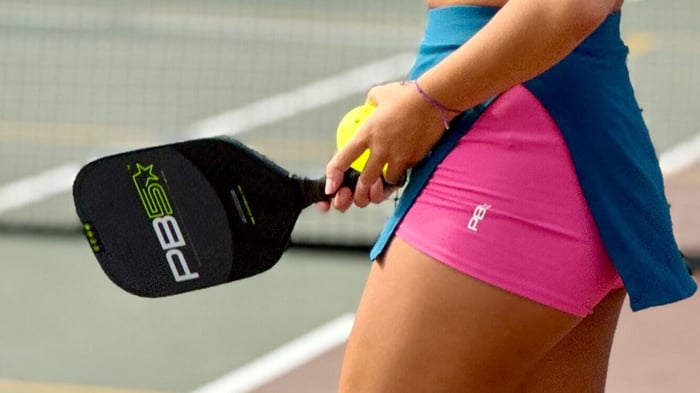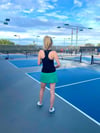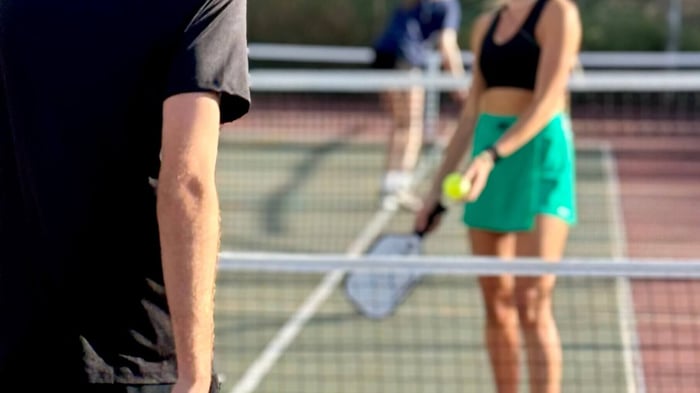Key takeaways:
Mastering basic hitting techniques and engaging in community-driven drills can elevate your pickleball skills and confidence on the court.
Precision and accuracy in pickleball come from consistent practice using specific drills, visualization, and reliable performance gear.
Overcoming common hitting pitfalls and unleashing power in your shots requires the right grip, body positioning, and paddle technology.
If you want to hit better in pickleball, it starts before you ever swing the paddle. Your grip, your stance, and your timing set the tone for every shot you take. Get those right, and it’s easier to stay balanced, adjust mid-rally, and stay in control when the pace picks up.
Improving those basics doesn’t mean grinding through hours of random drills. It means being intentional—building your skills with a clear focus, not just more reps. It also means using gear that moves with you and supports your style of play. PB5star gear is built to help you train, react, and compete at your pace, from warm-up to match point.
Want to learn how to hit a pickleball better? In this guide, we’ll break down how to sharpen your hitting step by step: building clean mechanics, training for better accuracy, fixing common mistakes, and knowing when to shift your tempo during a match.
Build better technique from the ground up
Before you think about power or placement, it’s worth checking in on the basics: your grip, your stance, and your footwork. These are the pieces that set you up for every clean hit—so if something feels off in your shot, this is where to look first.
Grip: A continental grip is versatile and easy to use—it lets you switch between forehand and backhand without needing to adjust. Hold the paddle like you’re shaking hands with it, and keep your wrist relaxed. If you’re squeezing too tight, your shots can start to feel rushed or tense.
Stance: Keep your knees slightly bent, your paddle up, and your weight ready to shift. A balanced stance helps you stay in control and react without needing to reset between shots. You want to feel ready, not rigid.
Footwork: As your opponent makes contact, take a quick split step to stay light on your feet. Then, use small, steady steps to get into position. Sharp footwork doesn’t mean fast feet—it means efficient movement between shots so you’re not chasing the ball with lunges or reaching across your body.
Wall drills: If you’re training on your own, wall drills are one of the easiest ways to stay sharp and build good habits. Add in some lateral or forward movement between shots to mimic real match patterns. You’ll build quicker reactions and better balance with every rep.
7–11 drill: If you're practicing with a partner, try the 7–11 drill. One player stays up at the net going for 11 points; the other plays back at the baseline aiming for 7. It sharpens your timing, improves spacing, and helps you focus on shot placement—not just pace.
Improve your accuracy through focused training
Landing your shots where you want them takes more than just reps—it takes intention. The best drills focus on specific targets, so you're training with a clear goal.
Wall work is a great place to start. Mark off a few zones and rotate through shot types—dinks, volleys, drives. And if you're working solo, structured solo drills can help you keep your form sharp and your focus high.
To push your accuracy further, you can try to:
Visualize your target before contact
Rotate drills so you don't fall into autopilot
Track patterns week to week to see where you're improving
Lightweight gear makes a difference during longer sessions. The Core Performance Tee keeps you cool and focused to stay in rhythm without adjusting layers between reps.
Fix common mistakes in your hitting technique
You’ve probably had stretches where your shots feel just a little off. Drives sail long, volleys fall short, or your timing doesn’t line up the way it usually does. Fixing those moments usually doesn’t involve rebuilding your whole swing, but rather it means noticing which parts of your game are slipping then making small changes to find your rhythm again.
Struggling with control?
Check your grip pressure. A tight grip makes your shots feel tense and rushed. Try loosening up just enough to stay in control without squeezing.
Overshooting the court?
Aim for clean, centered contact instead of swinging hard. When you rely on mechanics over muscle, your shots stay accurate. A few gentle resets at the kitchen line can help you re-center. Minor tweaks—like adjusting grip tension or shortening your backswing—can correct some common hitting mistakes without changing your whole swing.
Missing your targets?
A lot of the time, it's your feet. A quick repositioning before you hit can help with balance and shot direction. Shoes like the PB5 Court2 are built for these quick adjustments: light, responsive, and stable under pressure.
Volleys dropping short?
Make sure your paddle’s up and in front, and meet the ball early. Think of guiding the ball forward, not swinging at it—solid positioning and timing make all the difference at the net.
Generate more power with technique, not force
Power doesn't come from swinging harder—it comes from using your body more efficiently. The "load and explode" approach teaches you to build momentum from the ground up, transferring energy from your legs through your core and shoulders.
Start with a solid base. Keep your stance grounded, rotate through your hips and torso, and finish with a smooth follow-through. A connected swing delivers more power—and keeps your shot under control.
To build power with control:
Practice shadow smashes to fine-tune your motion
Try sharp-angle shots like ATP drills to work on pace and positioning
Use topspin to add speed without losing precision
The Balance paddle is designed for this kind of play—its balanced build and fiberglass face support power shots that stay within bounds.
Know when to play soft vs hard
Hitting hard can help you take control of a point, but it’s not always the right play. You have to know how to change the tempo—when to slow things down with a soft shot, and when to speed it up to put pressure on your opponent. Learning to shift gears makes it easier to reset, attack, and stay one step ahead without forcing every shot.
Use soft shots—like dinks, resets, and drops—when:
You're pulled out wide or off balance
You want to bring your opponent into the court
You need to slow down the point and reset
Go aggressive when:
You get a high ball or catch your opponent out of position
You're setting up a putaway off a weak return
You want to flip the pace and apply pressure
Reading the rhythm of a rally gives you options. When you know how to change speeds, you can set the pace and shape the game instead of just reacting to it.
Build consistency through smarter routines
Consistency doesn’t come from simply playing longer, you also need to practice with a clear plan. Breaking your sessions into phases—like movement work, drills, and game play—helps you stay sharp, work on real skills, and see more progress.
Here's one way to break it down:
Warm-up: Movement drills, resets, soft touches
Skill work: Pick one focus—serves, drives, dinks—and drill it with purpose
Situational play: Simulate game moments with point-based challenges
Cool-down: Slow things down, reinforce soft shots, and reset your timing
You don't have to train daily. Two or three focused sessions a week can build more progress than playing without a plan. Try rotating focus areas like this:
Week 1: Serve placement + short game
Week 2: Movement + resets
Week 3: Power + spin
Week 4: Shot selection + reactions
A good routine builds muscle memory and confidence. When you know what you’re working on and why, each session becomes more intentional and more productive.
Game-ready, anytime, anywhere
Strong hitting doesn't start with power—it starts with preparation. When your drills have structure and your gear supports your movement, each session adds to your confidence on the court.
Consistency builds off the court, too. With the right habits and tools, you'll show up ready—whether you're practicing solo or playing full speed. However you train, wherever you play, PB5star offers reliable gear and apparel built to move with you from warm-up to match point.







